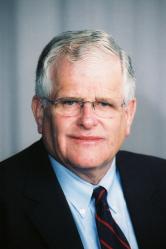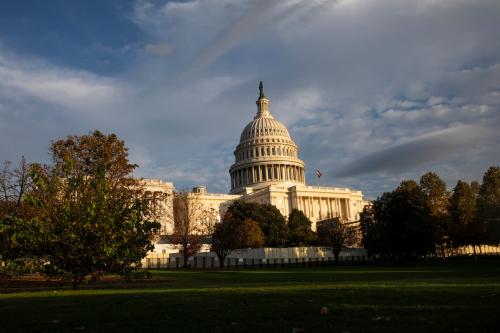Announcements by little-known federal agencies rarely spark a “political firestorm,” but that’s what the U.S. Judicial Conference did with a March 12 proposal involving judicial orders stopping nationwide enforcement of federal policies, so-called “national injunctions.” Specifically, the Conference proposed limiting plaintiffs’ ability to “judge shop” to ensure that sympathetic judges would hear their requests for such injunctions. Shortly thereafter, 19 Republican senators slammed the proposals on its merits and for encroaching on legislative authority while nine Democratic senators praised it for restoring public confidence in courts, and those were only opening salvos. (The Chief Justice of the United States presides over the semi-annual meetings of the 26-judge Judicial Conference and appoints the over 200 members of its some 20 committees, almost all of them federal judges. The Conference says it “serves as the policymaking body for the federal courts,” a less-than-precise summation of its actual authority.)
Emblematic of the cases that led to the Conference’s March 12 action is one that made national headlines and is now before the Supreme Court. Texas federal judge Matthew Kacsmaryk granted a request by a group of anti-abortion physicians to bar (“enjoin”) enforcement of Food and Drug Administration rules allowing mail distribution of abortion medicines. He applied his injunction to the whole country, not just to that part of Texas that Kacsmaryk serves. Quirks in federal court organization allowed the physicians to be sure their case would go before Kacsmaryk, whose anti-abortion views were well known. Kacsmaryk’s order is on hold pending appeal, but it raises two basic questions (apart from the abortion controversy itself).
First, should a single federal judge have the authority to stop duly enacted statutes and agency rules from being enforced anywhere in the country? Kacsmaryk’s FDA injunction is hardly the only “national” or “universal” injunction that judges (including Kacsmaryk) have issued. Parties left and right have sought them—12 during the George Bush administration, and 19 and 50 respectively during the Obama and Trump administrations. Policymakers and others, left and right, have attacked them, at least when judges have enjoined enforcement of laws that the policymakers favor. The Conference goal on March 12 was not ending such injunctions but rather making it difficult for plaintiffs seeking them to ensure that their case would go before a sympathetic judge.
Thus, the second question: Should federal court rules enable plaintiffs to secure a like-minded judge to hear their case—commonly known as “judge-shopping.” Allowing plaintiffs to pick their judge is contrary to the bedrock federal court principle of randomly assigning cases to judges through an electronic version of drawing names from a hat.
Successful judge-shopping combined with judges’ authority to issue national injunctions is obviously attractive to interest groups. Why try to change national policy by building legislative coalitions or lobbying federal agencies when one strategically selected federal judge can issue an injunction doing the same thing (at least if the appellate courts agree)?
In this post I try to:
- Clarify the federal court arcanum about the dispute;
- Explain the Conference’s proposed policy and the controversies over the policy and the Conference’s authority; and
- Speculate briefly on what may be next.
How could the physicians be sure that Judge Kacsmaryk would hear their case despite the principle of random case assignment? First, a little background. Congress has created 91 district courts and assigned from two to 28 judgeships to each district. And Congress has told each district court to adopt rules or orders for the assignment of cases to the district’s judges, to be administered by the district’s chief judge. Although not required by statute, district court assignment practices embrace the view that neither the judges nor the parties should be able to channel a particular case to a particular judge.
The Conference action that prompted the firestorm was a recommendation that each district court, upon the filing of a case seeking a national injunction, assign the case randomly to any judge in the district.
That is what would happen anyway in geographically compact districts, but random assignment can get complicated in districts with geographically scattered judges, such as the Northern District of Texas. It sprawls—as its website map shows—from the Dallas/Fort Worth metroplex, north to Wichita Falls, northwest to Amarillo and Lubbock, and southwest to San Angelo and Abilene. Rather than force remotely located attorneys and parties to drive up to six hours, or fly, to the district’s Dallas headquarters, Congress has divided the Northern District into seven geographic divisions, each with a place of holding court.
Within each of the Northern District’s multi-judge divisions, district court orders dictate random assignment. One for example, directs that “civil and criminal cases filed in the Fort Worth Division will be assigned by random draw” to the three judges listed. But in divisions with a single judge, random assignment can be a principle without an object—if the assignment plan provides that any case filed in the division get assigned to the single judge in the division.
Since his commissioning on June 21, 2019, Matthew Kacsmaryk has been the only resident federal judge in the Northern District’s Amarillo Division. In early July 2019, the Dallas-based chief judge at the time ordered a token random assignment—all criminal and civil cases filed in Amarillo would go to Kacsmaryk except that five percent of the civil cases would be randomly assigned to her. (This order tracked an earlier, pre-Kacsmaryk order).
When Dallas-based David Godbey became chief judge on September 6, 2022, he issued a superseding order that directed the clerk to assign all Amarillo cases to Kacsmaryk. In November 2022, the physicians filed their case in the Amarillo division, knowing Kacsmaryk would be their judge. The case moved fairly quickly from Kacsmaryk’s April 2023 decision in favor of the physicians through the court of appeals to the Supreme Court, which heard oral argument on March 26, 2024.
At oral argument, several justices expressed the same skepticism of national injunctions as have other policymakers. The anti-abortion physicians claimed they could be harmed (suffer “conscious injuries”) from having to treat emergency room patients injured by anti-abortion drugs. Justice Ketanji Jackson questioned not only that claim but, more relevant here, their additional claim, as she put it, “because we object to having to be forced to participate in this procedure, we’re seeking an order preventing anyone from having access to these drugs at all.” Justice Neil Gorsuch said, “this case seems like a prime example of turning what could be a small lawsuit into a nationwide legislative assembly on . . . an FDA rule or any other federal government action”.
Given bipartisan (albeit not universal) criticism of national injunctions, why did the Judicial Conference effort to regulate them spark a “firestorm”? After the Conference’s March 12, 2024, meeting, the Administrative Office, as it does after every biannual meeting, issued a press release highlighting Conference actions likely to reflect well on the judiciary. Thus, the March 12 release announced, “Conference Acts to Promote Random Case Assignment,” pointing to “[p]ublic debate” about “several highly controversial lawsuits, seeking nationwide injunctions against federal government policies [that were] filed in single-judge court divisions.” The Conference proposal was not to ban national injunctions or judge-shopping per se but a more limited proposal: National injunction cases, even if filed in a single-judge division, would be randomly assigned among all the district’s judges. (Had such a proposal been in effect in Northern Texas in November 2022, the physicians’ case could still be filed in Amarillo but would then be randomly assigned to one of the 16 district judges throughout the district. It could by chance go to Kacsmaryk, but random assignment would more likely send it to a judge in Dallas or Fort Worth, where most of the 16 are based.)
Confusion and controversy arose immediately over what the Conference proposed and its authority to do so.
First, the Conference’s March 12 press release seemed to describe a mandatory policy, but the Conference has no plenary authority to issue directives to the courts. The Conference gets most of its authority from the statutory directive that it supervise the Administrative Office of the U.S. Courts’ performance of its many court administration tasks. Congress has also authorized the Conference to issue binding rules to implement statutes governing judicial conduct complaints and judges’ and employees’ financial disclosure, gift receipts and outside income. Congress has also authorized it to prescribe federal court procedure and evidence rules through a process involving public notice and Supreme Court and congressional approval.
Beyond those specific authorities, the Conference statute describes a largely advisory body that may, among other things, “submit suggestions and recommendations to the various courts to promote uniformity of management procedures and the expeditious conduct of court business.” For contrast—and not at issue in the present controversy—note that Congress has authorized the judicial councils in each regional circuit to “make all necessary and appropriate orders for the effective and expeditious administration of justice within its circuit.”
Although the Conference has no plenary order-making authority, it sometimes talks as if it does, as seen in the March 12 press release. It characterized the Conference action as “limiting the ability of litigants to effectively choose judges” but added that “[d]istrict courts may continue to assign cases to a single judge” if the cases are not seeking national injunctions. “[L]imiting the ability” and “may continue” have the ring of a mandate. Furthermore, the release described the Conference’s actions as “policy” (“[t]he policy addresses all civil actions that seek to bar . . .”). It used the same word—“policy”— to describe the clearly mandatory statutes and agency rules at issue (the “federal government policies” against which plaintiffs seek injunctions). The chair of the Conference’s executive committee also spoke of the action in terms suggesting a mandate.
The release also included, as is routine, the Conference’s boilerplate description of itself as “the policy-making body for the federal court system,” probably leading one sympathetic if not very curious advocate to say what many others no doubt assumed: “. . . Congress created the Judicial Conference to make policy for the courts! It is doing what it’s supposed to do.”
Observers soon began objecting that the Conference had no authority to mandate adherence to its “policy” and by the end of the week, the Conference, as the press release promised, issued Guidance for Civil Case Assignment in District Courts. Although the guidance document also toggled between suggestion-sounding versus mandate-sounding verbiage, opponents were satisfied that the Conference was not trying to require districts to change assignment practices. The Northern District’s chief judge, for one, responded to Senate Majority Leader Chuck Schumer’s letter encouraging policy compliance by advising him that the “consensus” among the Northern District’s judges was to make no change “at this time.”
Second, what were the main objections to the policy? Some objected that the policy disfavored conservative litigants. One prominent conservative commentator argued at length that the federal judicial selection process, at least currently, places in “the far-flung corners of the state [judges who are] likely to be younger, less entrenched in polite society, and more comfortable with cutting-edge legal jurisprudence.” Thus goes the argument, the policy would deprive innovative conservative plaintiffs (like the physicians who sued in Amarillo) of preferred venues for national injunctions and shift their litigation to urban divisions where they are less likely to find sympathetic judges.
The more commonly voiced argument was that the Conference had stepped into the legislative sphere. Senate Minority Leader Mitch McConnell told a Kentucky chief federal judge that his district had no obligation to adopt the policy and added that if the statute authorizing districts to develop their own assignment systems needs changing, “you can rest assured that Congress—and not the Judicial Conference—will make the relevant changes.”
What’s next? On the legislative front, in early April, Schumer and other Democrats issued an attention-grabbing press release excoriating the Northern District (“Texas District Court Defies Necessary Judicial Conference Policy. . .”) and introduced a one paragraph bill to codify the Conference policy. McConnell and a few other Republicans, citing national injunctions against Trump administration policies and judge-shopping in Alabama by transgender care proponents, introduced a longer bill to end national injunctions by restricting injunctions’ applicability to the parties in the case and others like them in the district. To limit judge-shopping, rather than codify the Conference proposal, the bill would create a disciplinary mechanism for lawyers who engaged in various tactics to interfere in random assignment.
Chances of passage of either proposal in this Congress are nil.
Although the propriety of national injunctions arose tangentially in Supreme Court oral argument in the FDA case, that Court is unlikely to use this case to make a definitive ruling on such injunctions, but it might in some future case.
The administrative agencies of the federal judiciary, having been burned by a less-than-perfect roll-out, will likely go easy in encouraging compliance with this Conference recommendation, lest they stir up more partisan fights. In different times, the Conference might try to use the process referenced above by which Congress has delegated to the Conference the authority to issue national rules governing federal court procedure. Such rules have the force of superseding law (“All laws in conflict with such rules shall be of no further force or effect after such rules have taken effect.”) and could modify the current provision vesting assignment authority in district courts. It is a slow and largely public process, and, especially relevant here, Congress can veto proposed rules before they take effect.
In short, changes in single-division case assignments are unlikely to come from any national statute or rule but rather by selective and varied implementation in the district courts, characterized as they are by many distinct local legal cultures.
Almost 100 years ago, Professor and Justice-to-be Felix Frankfurter wrote that matters of court administration do not always “involve merely technical questions of judicial organization” but may involve “passionate issues of power.” So too with these competing arguments over case assignment practices and national injunctions, given the partisan controversies motivating the arguments.
The Brookings Institution is committed to quality, independence, and impact.
We are supported by a diverse array of funders. In line with our values and policies, each Brookings publication represents the sole views of its author(s).








Commentary
Effort to curb judge-shopping at the federal courts explained
April 18, 2024